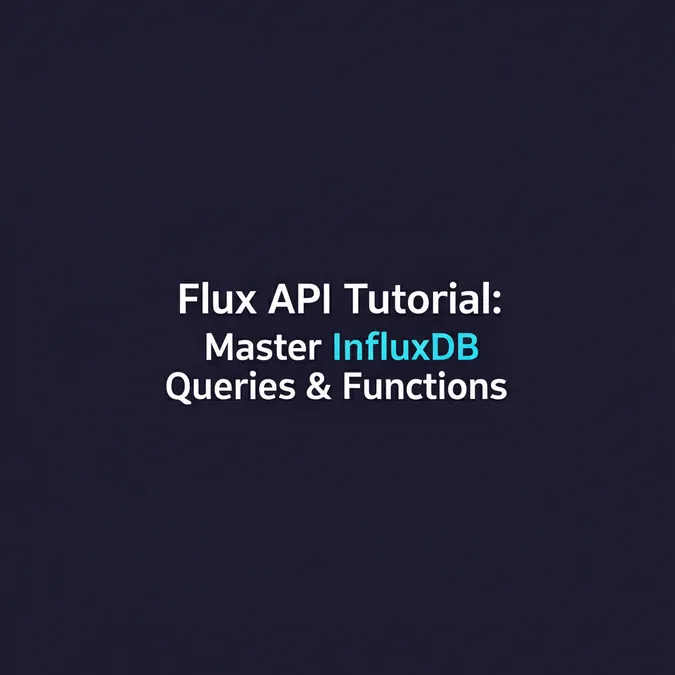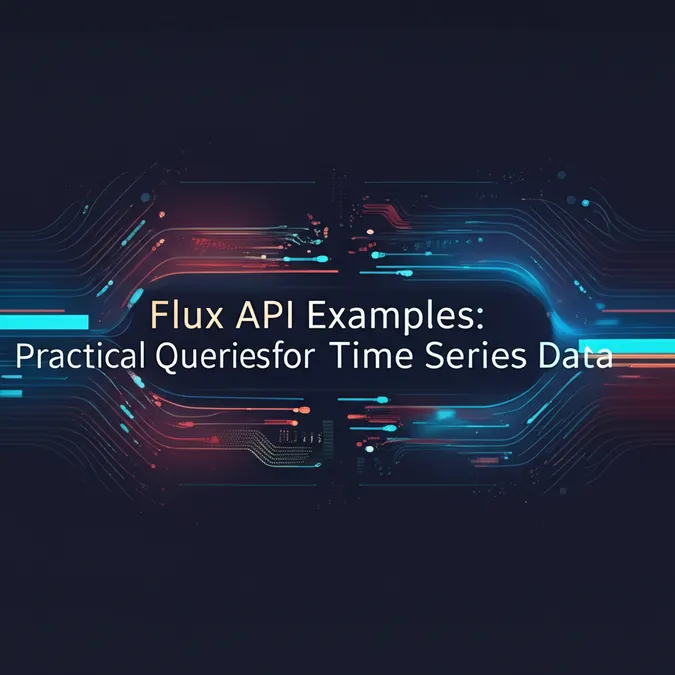Developer Offer
Try ImaginePro API with 50 Free Credits
Build and ship AI-powered visuals with Midjourney, Flux, and more — free credits refresh every month.
Flux API vs InfluxQL: Choosing the Right Query Language
Flux API vs InfluxQL: Choosing the Right Query Language
This article will help you decide between Flux and InfluxQL for querying your InfluxDB time series data by comparing their features, benefits, and ideal use cases.
Introduction: The Evolving Landscape of InfluxDB Querying
InfluxDB is a popular open-source time series database designed to handle high write and query loads. For years, InfluxQL, a SQL-like query language, was the primary way to interact with InfluxDB. However, with the release of InfluxDB 2.0, a powerful new language called Flux was introduced, eventually becoming the recommended query language for influxdb 2.0 flux and subsequent versions.
Understanding the differences between Flux vs InfluxQL is crucial for developers working with InfluxDB, whether starting new projects or maintaining existing ones. It's also worth noting that while this article focuses on InfluxData's Flux for time series data, the term "Flux API" can sometimes appear in other technological contexts, such as AI image generation. For example, services like imaginepro.ai provide access to advanced AI image models, sometimes using similar API descriptors. However, our discussion here is centered on Flux as the data scripting and query language within the InfluxDB ecosystem.
What is InfluxQL? The SQL-Like Veteran
InfluxQL (Influx Query Language) is designed to be familiar to anyone with SQL experience. Its syntax is straightforward for common time series operations like selecting data, filtering by time or tags, and grouping results.
Key Characteristics of InfluxQL:
- SQL-like Syntax: Easy to learn for those familiar with SQL.
- Simplicity for Basic Queries: Well-suited for straightforward data retrieval and aggregation.
- Established: Widely used with InfluxDB 1.x versions, meaning a large amount of existing code and community knowledge.
Example InfluxQL Query:
To select the average CPU usage from the cpu_usage measurement for the last hour, grouped by the host tag:
SELECT mean("usage_system")
FROM "cpu_usage"
WHERE time > now() - 1h
GROUP BY "host"
While simple for such tasks, InfluxQL's capabilities become limited when dealing with more complex analytical requirements, such as joining data from different measurements or performing advanced mathematical transformations.
Understanding Flux: The Modern Data Scripting Language
Flux is more than just a query language; it's a powerful functional data scripting language designed specifically for time series data. It offers significantly more flexibility and power than InfluxQL. Understanding flux query language basics involves grasping its functional nature and its data-pipelining concept.
Key Characteristics of Flux:
- Functional Syntax: Data flows through a series of functions connected by the pipe-forward operator (
|>). - Composability: Queries are built by chaining functions, making complex logic easier to construct and read.
- Extensibility: Allows for custom functions and integrations with external systems.
- Powerful Data Transformation: Excels at complex data shaping, joins, mathematical operations, and more.
Example Flux Query: The equivalent Flux query for the InfluxQL example above:
from(bucket: "my-bucket")
|> range(start: -1h)
|> filter(fn: (r) => r._measurement == "cpu_usage" and r._field == "usage_system")
|> group(columns: ["host"])
|> mean()
This syntax, while different from SQL, provides a clear representation of the data transformation pipeline.
Flux vs InfluxQL: A Head-to-Head Comparison
To better illustrate the Flux vs InfluxQL differences, let's compare them across several key aspects:
| Feature | InfluxQL | Flux |
|---|---|---|
| Syntax | SQL-like, declarative | Functional, data-flow oriented, scriptable |
| Learning Curve | Easier for SQL users for basic queries | Steeper initially, but powerful once concepts are grasped |
| Power & Flexibility | Limited for complex analytics and transformations | Highly powerful and flexible for diverse data operations |
| Data Transformation | Basic aggregation and filtering | Advanced data shaping, windowing, pivoting, calculations |
| Joins & Cross-Data | Limited to JOIN within the same measurement (in some versions), difficult across measurements | Native support for joins across measurements, fields, and even buckets |
| Readability | Clear for simple queries | Can be very readable for complex logic due to explicit data flow |
| Primary Use Case | Basic time series querying in InfluxDB 1.x | Advanced analytics, data processing, tasks, alerts in InfluxDB 2.x+ |
| InfluxDB Version | Primarily InfluxDB 1.x (supported in 2.x for compatibility) | Primary language for influxdb 2.0 flux and newer versions |
Key Benefits of Using Flux API over InfluxQL
There are compelling benefits of using flux api over influxql, especially for modern time series applications:
- Advanced Analytical Capabilities: Flux includes a rich library of built-in functions for complex mathematical operations, statistical analysis, anomaly detection, and more, far exceeding InfluxQL's scope.
- Greater Expressiveness: Its functional nature allows for more expressive and sophisticated queries, handling scenarios that would be cumbersome or impossible with InfluxQL.
- Powerful Data Joins and Unions: Flux can easily join data from different measurements, buckets, and even external data sources (with appropriate packages), enabling richer contextual analysis.
- Data Scripting Beyond Queries: Flux is not just for querying. It's used to define tasks (scheduled Flux scripts), alerts, and custom data processing pipelines directly within InfluxDB.
- Extensibility: Users can define their own custom Flux functions and import packages to extend its capabilities further.
- Integration with External Systems: Flux can query other databases (e.g., SQL databases, CSV files) and send data to other systems, making InfluxDB a more versatile part of a larger data ecosystem.
When to Choose Flux (and When InfluxQL Might Still Suffice)
The choice between Flux vs InfluxQL largely depends on your project requirements and your InfluxDB version.
Choose Flux if:
- You are starting a new project with InfluxDB 2.x or newer.
- Your application requires complex data analysis, transformations, or joins across different datasets.
- You need to implement server-side logic like scheduled tasks or sophisticated alerting.
- You want to leverage the full capabilities of
influxdb 2.0 fluxand its ecosystem. - You appreciate the power and expressiveness of a functional data scripting language.
InfluxQL might still be considered if:
- You have a significant existing codebase in InfluxQL for an InfluxDB 1.x instance, and immediate migration isn't feasible.
- Your query needs are extremely simple (e.g., basic
SELECT ... FROM ... WHERE ... GROUP BY ...) and unlikely to become more complex. - You are strictly working within an older InfluxDB 1.x environment with no plans to upgrade.
Considerations for Migrating from InfluxQL to Flux
Migrating from InfluxQL to Flux is not a direct one-to-one translation due to the fundamental differences in language paradigms. It often requires rethinking how you approach data manipulation.
- Learning Curve: Expect a learning curve as your team gets accustomed to Flux's functional syntax and data flow model.
- Query Re-Design: Many InfluxQL queries will need to be redesigned rather than directly translated to leverage Flux's strengths effectively.
- Tooling: InfluxDB's UI includes a "Script Editor" that can help in building and debugging Flux queries. Some tools might offer limited assistance in converting simple InfluxQL queries.
- Resources: Leverage official documentation and community resources. InfluxData provides excellent Flux documentation to get started. For InfluxQL, historical documentation is also available InfluxQL Reference.
Conclusion: Embracing the Future with Flux
While InfluxQL served its purpose well for simpler time series queries, Flux represents the future of data interaction with InfluxDB. Its power, flexibility, and extensibility make it far better suited for the complex analytical demands of modern applications. For new projects on InfluxDB 2.0 and beyond, learning and adopting Flux is highly recommended. The decision in the Flux vs InfluxQL debate leans heavily towards Flux for its superior capabilities and its role as the primary language for current and future InfluxDB development. By understanding flux query language basics and the benefits of using flux api over influxql, developers can unlock deeper insights from their time series data.
Compare Plans & Pricing
Find the plan that matches your workload and unlock full access to ImaginePro.
| Plan | Price | Highlights |
|---|---|---|
| Standard | $8 / month |
|
| Premium | $20 / month |
|
Need custom terms? Talk to us to tailor credits, rate limits, or deployment options.
View All Pricing Details

